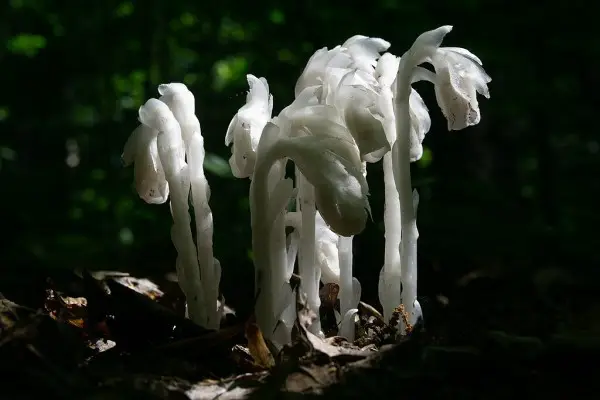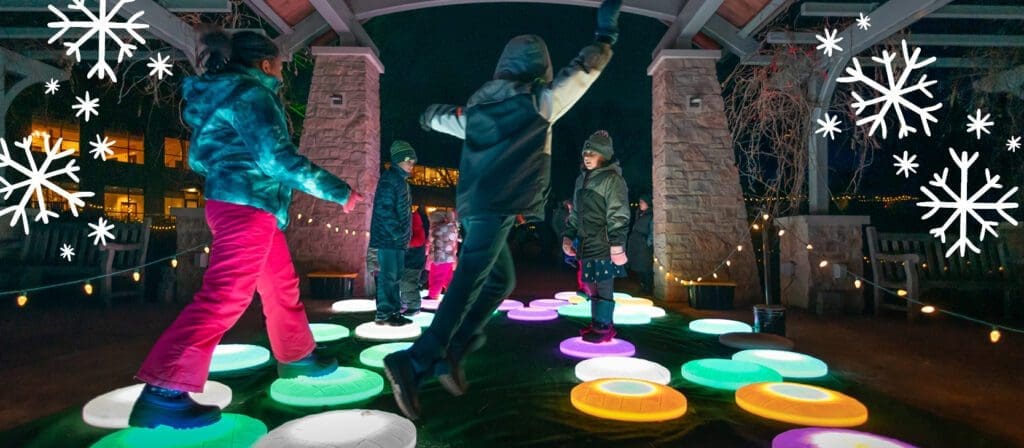Since it’s finally autumn, it’s officially the season of frights! While you may not expect it, there are certainly a few creepy characters right outside your doorstep. From gloopy yellow masses to sneaky parasites, here are just a few ghoulish plants and protists found in our home state of Wisconsin.
Ghost Pipe
While uncommon3, it’s hard to miss ghost pipe on the forest floor. White as a sheet, it starkly contrasts the lush green of other flora. Ghost pipe doesn’t need green chlorophyll; in fact, it doesn’t photosynthesize at all. Instead, it’s a mycotroph and supports itself by parasitizing fungi.2 Ghost pipe roots reach out to connect with expansive conifer mycorrhizal networks. Tapping into the resources that the fungi receives through conifers roots, ghost pipe is able to survive.4

Ghost pipe can be found in most areas of the United States and Canada.3 Keep an eye on the forest floor next time you’re hiking through a shady conifer forest in our warmer months.4 If you’re lucky, you just might see a “ghost”.
Roundleaf Sundew
Roundleaf sundew is as crazy as it looks. Its bright red color attracts insects, luring them to their untimely demise. Once an insect lands, it finds that the droplets on the hairs of each leaf are deceptively sticky, like a fly trap. Once it’s entangled, the roundleaf sundew takes action, folding its leaf over the prey to prevent its escape. Finally, digestive fluids are released, allowing for nutrient absorption.6

While roundleaf sundew certainly has some unsavory methods of survival, it’s well adapted to the bog environment that it lives in. While they have plenty of sunlight, bogs lack the nutrients that are critical for plant growth and reproduction. Insects are able to fill in the gaps for sundew and other carnivorous bog plants5 like pitcher plants and Venus fly traps.
Dog Vomit Slime Mold
With its garish yellow color and goopy texture, dog vomit slime mold definitely earns its name. It puts on quite a show, but it’s nowhere near as scary as it looks. Slime molds are protists and don’t have hyphae like fungi do. Instead, they’re largely structureless. Eventually, this slimy glob is replaced by a puffy fruiting body. When it hardens and changes color, it spores out to reproduce when the surface is disrupted.1

Dog vomit slime mold is distributed globally and can often be found on decaying wood in moist shaded areas (like hardwood mulch). Thankfully, it’s harmless to plants, pets, and humans, though it can be an allergen and certainly isn’t considered edible.1
While these are just a few examples, there are so many more frightening facts to learn! The world of botany is full of surprises, so pick up a book or do a quick search to continue your exploration. Happy haunting!
Sources
- Mahr, Susan. “Dog Vomit Slime Mold, Fuligo Septica.” Master Gardener Program, July 31, 2015. https://mastergardener.extension.wisc.edu/files/2015/12/DogVomitSlimeMold.pdf.
- “Monotropa Uniflora – One-Flowered Indian-Pipe.” Native Plant Trust: Go Botany, gobotany.nativeplanttrust.org/species/monotropa/uniflora/. Accessed 10 Sept. 2023.
- “Monotropa Uniflora.” USDA, www.fs.usda.gov/wildflowers/beauty/mycotrophic/monotropa_uniflora.shtml. Accessed 10 Sept. 2023.
- “Montropa Uniflora.” Botanical Society of America, cms.botany.org/home/resources/parasitic-plants/monotropa-uniflora.html. Accessed 10 Sept. 2023.
- “Roundleaf Sundew (Drosera Rotundifolia).” Adirondacks Forever Wild. Accessed September 30, 2024. https://wildadirondacks.org/adirondack-wildflowers-roundleaf-sundew-drosera-rotundifolia.html.
- Wolf, Evan, Edward Gage, and David J Cooper. “Drosera Rotundifolia L. (Roundleaf Sundew).” U.S. Department of Agriculture, June 29, 2006. https://www.fs.usda.gov/Internet/FSE_DOCUMENTS/stelprdb5250874.pdf.





